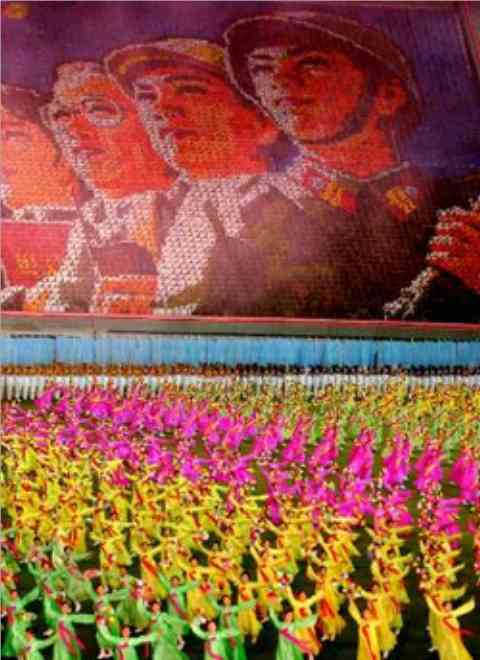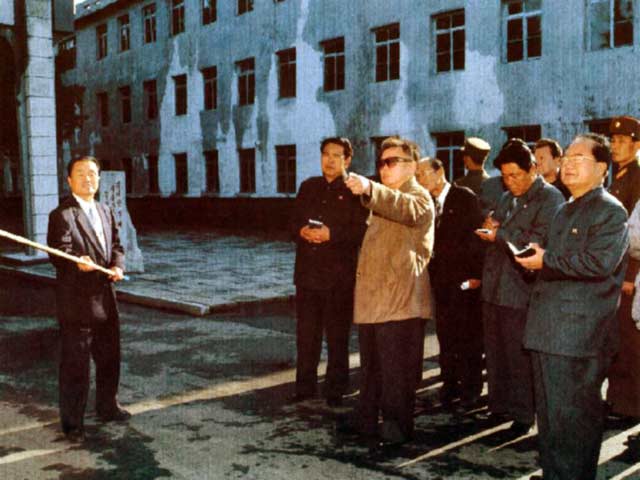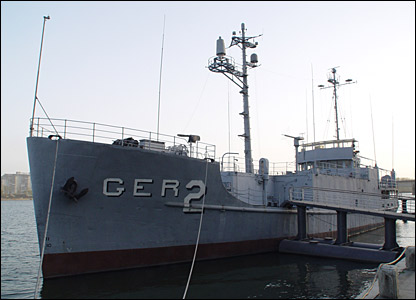If We Knew for Sure, What Then?
North Korea Tested Lethal Gas on Humans - WiesenthalThere will one day spring from the brain of science a machine or force so fearful in its potentialities, - Thomas A Edison The healthy man does not torture others - generally it is the tortured who turn into torturers. - Carl Gustav Jung
Seoul: North Korea conducted lethal chemical experiments on humans until 2002 as part of a programme to develop weapons of mass destruction, a human rights group said yesterday, quoting former scientists from the communist state. Rabbi Abraham Cooper of the Simon Wiesenthal Centre said the scientists gave first-person testimony describing gassing of political prisoners in the North from the 1970s until 2002. "We can basically, I think collectively conclude that North Korean political prisoners are gassed," he told reporters. Cooper said the testimonies, if true, indicated the existence of functional gas chambers, where enemies of state were eliminated with no sense of remorse. "That makes a mockery of the lessons that civilisation alleges that it has learned since the end of World War 2." Cooper urged the international community and the South Korean government to look hard at the allegations. "Such barbaric practices, if proven, should lead to legal action against its instigators and perpetrators," Cooper said. The South Korean government had questioned the validity of previous reports on human chemical testing in North Korea. North Korea has previously denied the reports, calling them a US "smear campaign" designed to justify war against it. Two of the scientists cited were those who had previously provided testimony that resulted in a BBC television report earlier this year about gassing of political prisoners in experimental gas chambers in the North, Cooper said. The third was a former chemist in North Korea who had been involved in experiments using gas that killed immediately and another type that killed slowly, he added. The latter claimed to have worked only with animals, but the result of "successful" tests would then be turned over to colleagues who "experimented on human guinea pigs," Cooper said. The witness fled the communist state in 2002 and now lived in South Korea. Victims in the experiments described by the other two witnesses were put into a glass cell hooked up for audio, Cooper said quoting one of the witnesses. "It didn't just take two and a half hours for a prisoner to die. There was two-way communication in terms of audio," he said, adding this implied the scientists were also monitoring the degree of suffering during a slow death. I don't think there is any question that such practices continue to take place." The alleged experiments, while similar to gassing of Jews by the Nazis during World War 2, were different in that they were part of a programme to develop weapons of mass destruction, he said. Cooper said a lack of denial of the experiments at a meeting with a South Korean Foreign Ministry official yesterday suggested Seoul had independent verification of such experiments. But Foreign Ministry spokesman Lee Kyu-hyun denied this. "We do not have independent sources who can confirm the experiments," he said. Pyonygang has admitted to operating a nuclear weapons programme based on plutonium technologies and is also accused of secretly operating one based on uranium, something it has denied. The programmes are at the centre of slow-moving, six-country negotiations by the two Koreas, the United States, Japan, Russia and China aimed at stopping the North's programmes. North Korea's official media yesterday denied a Japanese media report that it had sold fluorine gas - used to manufacture weapons-grade uranium - to Iran. "Explicitly speaking, there had never been any negotiation or dealing between the DPRK and Iran as regards the nuclear issue," the North's KCNA news agency said, using its official name, the Democratic People's Republic of Korea. Source: stuff.co.nz 24 November 2004 See also:
North Korea: Joyful Dancing
North Koreans perform during the country's famed Arirang Mass Games at the May Day stadium in central Pyongyang October 14, 2005.
North Korea: More Joyful Dancing
The Buffalo by Andreas Lorenz The people of North Korea are not as submissive as they appear to be. Unnoticed by the outside world, strong opposition to the regime of dictator Kim Jong Il is beginning to appear. On 22 April 2004, two trains loaded with chemicals exploded in the city of Ryongchon. Although 169 people died or were horribly disfigured, including a large number of children from a nearby school, no functionaries appeared in the city to comfort the injured and the relatives of the victims. President Kim Jong Il did not even condescend to issuing a telegram offering his condolences. The state-owned news agency barely managed to devote a few lines to the catastrophe. Instead, the military in the capital celebrated the 72nd anniversary of the founding of the army and "Dear Leader" Kim with "joyful dancing" (the government's term). No pity and no compassion for the suffering victims. The regime showed its true face - once again. A few hours prior to the tragedy, Kim's special train passed through the Ryongchon train station, returning from a trip to China. Is it possible that this was not an accident, but instead an attempt by opponents of the regime to blow up the dictator and his entourage? Until now, the world has been under the impression that the North Koreans, shielded from information about the outside world, weakened by hunger and subject to the tyranny of a foolproof monitoring system, are incapable of rebelling. After all, didn't they succumb to collective hysteria in 1994 when, after living through decades of his cult of personality, they were suddenly faced with the death of Kim's father, the founder of the state, "Great Leader" Kim Il Sung? But the 22.5 million people of this country are not as submissive as they appear to be. In the bitter years of the mid-1990s, when the regime allowed up to three million people to die from malnutrition and weakness, demonstrations repeatedly flared up against the country's bizarre ruler who, with his blow-dried hair and eccentric uniforms, is partial to preaching to his exhausted citizens in so-called spontaneous lectures. Slogans against the dictator ("Down with Kim Jong Il") appeared on railroad cars, overpasses and factory walls. Flyers condemning the dynasty's unbelievable ostentation were even posted outside the Kumsusan Mausoleum in Pyongyang, where the elder Kim's embalmed body lies in state. In a new, soon-to-be-published book about North Korea, Jasper Becker, 48, a British author and journalist living in Beijing, writes that factories, military units, and even entire towns revolted against the leadership in Pyongyang. In conversations with North Korean refugees, members of the South Korean intelligence service and scientists, Becker offers a deep, virtually unprecedented look into the secretive country. For example, Becker obtained details about the biggest labour demonstrations in North Korea's history, which took place in 1998 in the industrial city of Songrim. The protests began on a cold February morning after the public execution of 8 men, all managers at the Hwanghae Iron and Steel Works. Their crime? In an effort to provide food for the workers and their families, they sold parts of the factory to Chinese businessmen. Even though many of Songrim's inhabitants were starving at the time, the attempt to circumvent the defunct public supply system to obtain food was considered sabotage and treason. The deal with wealthy comrades from the other side of the border was quickly exposed when Chinese grain freighters were seen openly unloading cargo designated for Songrim at the port of Nampo. When the bodies of the 8 functionaries, including two Central Committee members, fell into the dust, a woman in the crowd yelled: "They did not try to enrich themselves, but to help the workers. Shooting them is brutal." The courageous woman was one of the town's most respected citizens. As a nurse working in an elite hospital in Pyongyang, she had even taken care of the country's leaders. But that didn't protect her. Three soldiers grabbed the woman and shot her on the spot. The crowd, deeply fearful and horrified, quickly dispersed. A few hours later, however, the factory's employees stopped working. The peaceful protest was short-lived. The next morning, tanks broke through the factory gates and mowed down the demonstrators. According to eyewitness reports, hundreds lost their lives. Several days later, dozens of suspected agitators were shot, and countless so-called counter-revolutionaries and their families were taken away to labour camps. This was apparently not an isolated incident. Resentment against Kim is deeply entrenched in the population. Even a few of Kim's 450 hand-picked bodyguards, referred to as the "2-16 Unit," in honour of the dictator's birthday, apparently attempted to shoot their boss in the mid-1990s. Generals pushing for economic reforms planned a coup in 1992. Their leaders included the vice-commander of an army unit in Hamhung and deputy general staff commander An Jong Ho. Both were exposed and executed; their cohorts managed to escape to Russia. In the bleak northern industrial city of Chongjin, several officers attempted to take control of the port and rocket bases in 1995, as well as to convince other military units to join them and march on Pyongyang. Other members of the military plotted to fire a shell at Kim's platform during a military parade in the capital. A military resistance group calling itself "The Supreme Council of National Salvation" threw flyers from trains and trucks, reading: "We appeal to the soldiers of the People's Army and to the people to join us in our fight." The omnipresent state security service exposed the plots. Kim himself has now constructed a protective wall around himself. He constantly moves from one residence to another, and his houses in Pyongyang are connected by a system of tunnels. An elite unit of 100,000 soldiers dedicated to Kim exists solely to protect him against conspiracies. The uprisings happened at a time when even the privileged military was suffering and soldiers were starving in their barracks. During the 1990s, soldiers marauded throughout the country, looking for food. Most factories were shut down, the power was only on for a few hours each day, if at all, and water no longer flowed from faucets. The situation was not solely attributable to droughts, as the government attempted to convince its subjects. The Kim dynasty had taken the country to the brink of ruin, because it refused to loosen the reins on its calcified planned economy and allow the people to farm small private lots. It was not until 1994, when the elite began to feel the effects of this mistake, that Kim asked for foreign aid. The famine did not begin in the early 1990s, as is commonly assumed, but much earlier. An agricultural expert who fled the country began discovering the first signs of famine in 1987. But in a North Korea dominated by the cult of personality, no one dared inform old Kim Il Sung about the situation. By the time the "Great Leader" became aware of the problem, it was already too late. As Becker discovered, a serious disagreement between father and son must have occurred during this period. The patriarch was furious because his son had kept the economy crisis concealed from him for so long. Kim junior apparently opposed his father's plan to reform the economy based on the Chinese model, and to seek reconciliation with his South Korean compatriots. When Kim Il Sung died of heart failure in his villa on July 8, 1994, things may not have been entirely above-board. Apparently, his son forbade doctors from entering his father's room for a long period of time. Two of the 5 helicopters that were to take the corpse and the dead man's entourage to Pyongyang crashed, killing the doctors and bodyguards on board. Other functionaries later disappeared without a trace. While the North Koreans starved and the country descended ever more deeply into poverty, the younger Kim built at least 10 palaces, complete with golf courses, stables and movie theatres. His garages are filled with luxury cars. The CIA estimates the family's wealth at four billion dollars, part of which is deposited in Swiss bank accounts. Astonishing details about the lifestyle of the current president have now come to light. In the 1980s, he launched the "Project to Guarantee the Longevity of the Great and the Dear Leader." What this means, specifically, is that about 2,000 young women serve the leadership in "satisfaction teams" (sexual service) and "happiness teams" (massage). Kim himself selected Ko Yong Hi, a dancer, as his life partner, even though he was already married at the time and also had a mistress. Ko bore him two sons and was given the honorary titles "Great Wife" and "Beloved Mother." She has long since died, supposedly of cancer. One of her sons may carry on the dynasty. Translated from German by Christopher Sultan Source: service.spiegel.de Spiegel Online International 30 October 2004
Enemy Presence
The USS Pueblo is an incongruous presence, moored as it is in the centre of Pyongyang.
For articles on bioterrorism, patriotism enforcers, airport security, children in war, McCarthyism, humanitarian killing, Voice of America, pipelines, truth, lessons, anthrax, hatred and pain click the
"Up" button below to take you to the Index page for this War on Terrorism section. |
 Animals
Animals Animation
Animation Art of Playing Cards
Art of Playing Cards Drugs
Drugs Education
Education Environment
Environment Flying
Flying History
History Humour
Humour Immigration
Immigration Info/Tech
Info/Tech Intellectual/Entertaining
Intellectual/Entertaining Lifestyles
Lifestyles Men
Men Money/Politics/Law
Money/Politics/Law New Jersey
New Jersey Odds and Oddities
Odds and Oddities Older & Under
Older & Under Photography
Photography Prisons
Prisons Relationships
Relationships Science
Science Social/Cultural
Social/Cultural Terrorism
Terrorism Wellington
Wellington Working
Working Zero Return Investment
Zero Return Investment


